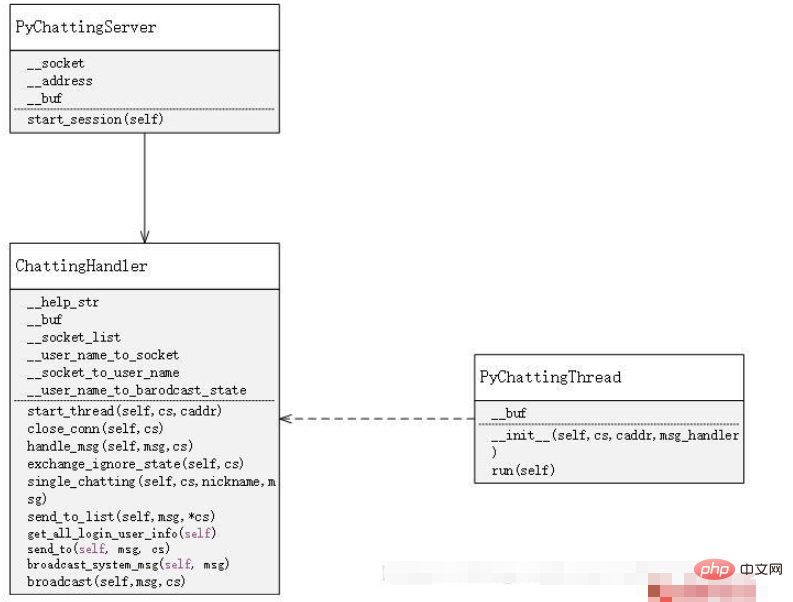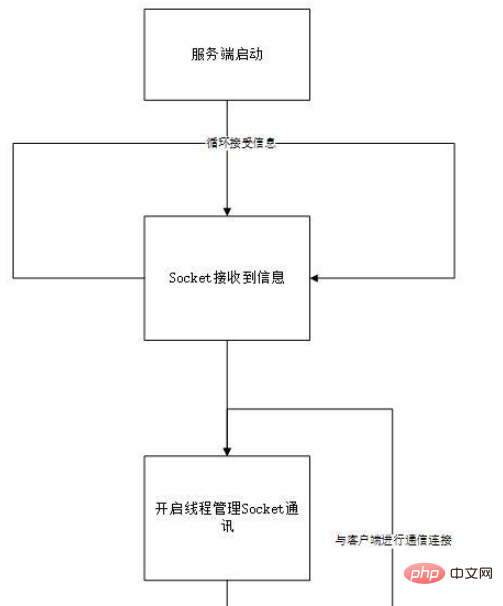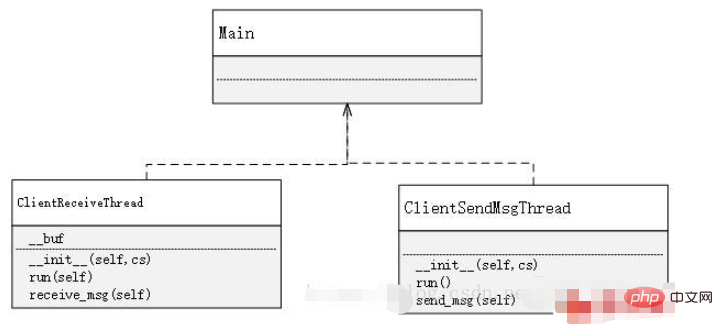Tutorial on writing a simple chat program in Python
May 08, 2023 pm 06:37 PMImplementation ideas
x01 Establishment of the server
First, on the server side, use socket to accept messages. Every time a socket request is accepted, a socket is opened. A new thread is used to manage the distribution and acceptance of messages. At the same time, there is a handler to manage all threads, thereby realizing the processing of various functions of the chat room
x02 Establishment of the client
The establishment of the client is much simpler than the server. The function of the client is only to send and receive messages, and to enter specific characters according to specific rules to achieve the use of different functions. Therefore, in On the client side, you only need to use two threads, one is dedicated to receiving messages, and the other is dedicated to sending messages. As for why not use one, that is because, if you only use one, then After receiving a message, the one that receives the message is in a blocked state before sending it. Similarly, the same is true for sending a message. If these two functions are implemented in one place, it will make it impossible to continuously send or receive messages.
Implementation method
Server-side implementation

import?json
import?threading
from?socket?import?*
from?time?import?ctime
class?PyChattingServer:
????__socket?=?socket(AF_INET,?SOCK_STREAM,?0)
????__address?=?('',?12231)
????__buf?=?1024
????def?__init__(self):
????????self.__socket.bind(self.__address)
????????self.__socket.listen(20)
????????self.__msg_handler?=?ChattingHandler()
????def?start_session(self):
????????print('等待客戶連接...\r\n')
????????try:
????????????while?True:
????????????????cs,?caddr?=?self.__socket.accept()
????????????????#?利用handler來管理線程,實現(xiàn)線程之間的socket的相互通信
????????????????self.__msg_handler.start_thread(cs,?caddr)
????????except?socket.error:
????????????pass
class?ChattingThread(threading.Thread):
????__buf?=?1024
????def?__init__(self,?cs,?caddr,?msg_handler):
????????super(ChattingThread,?self).__init__()
????????self.__cs?=?cs
????????self.__caddr?=?caddr
????????self.__msg_handler?=?msg_handler
????#?使用多線程管理會話
????def?run(self):
????????try:
????????????print('...連接來自于:',?self.__caddr)
????????????data?=?'歡迎你到來PY_CHATTING!請輸入你的很cooooool的昵稱(不能帶有空格喲`)\r\n'
????????????self.__cs.sendall(bytes(data,?'utf-8'))
????????????while?True:
????????????????data?=?self.__cs.recv(self.__buf).decode('utf-8')
????????????????if?not?data:
????????????????????break
????????????????self.__msg_handler.handle_msg(data,?self.__cs)
????????????????print(data)
????????except?socket.error?as?e:
????????????print(e.args)
????????????pass
????????finally:
????????????self.__msg_handler.close_conn(self.__cs)
????????????self.__cs.close()
class?ChattingHandler:
????__help_str?=?"[?SYSTEM?]\r\n"?\
?????????????????"輸入/ls,即可獲得所有登陸用戶信息\r\n"?\
?????????????????"輸入/h,即可獲得幫助\r\n"?\
?????????????????"輸入@用戶名?(注意用戶名后面的空格)+消息,即可發(fā)動單聊\r\n"?\
?????????????????"輸入/i,即可屏蔽群聊信息\r\n"?\
?????????????????"再次輸入/i,即可取消屏蔽\r\n"?\
?????????????????"所有首字符為/的信息都不會發(fā)送出去"
????__buf?=?1024
????__socket_list?=?[]
????__user_name_to_socket?=?{}
????__socket_to_user_name?=?{}
????__user_name_to_broadcast_state?=?{}
????def?start_thread(self,?cs,?caddr):
????????self.__socket_list.append(cs)
????????chat_thread?=?ChattingThread(cs,?caddr,?self)
????????chat_thread.start()
????def?close_conn(self,?cs):
????????if?cs?not?in?self.__socket_list:
????????????return
????????#?去除socket的記錄
????????nickname?=?"SOMEONE"
????????if?cs?in?self.__socket_list:
????????????self.__socket_list.remove(cs)
????????#?去除socket與username之間的映射關(guān)系
????????if?cs?in?self.__socket_to_user_name:
????????????nickname?=?self.__socket_to_user_name[cs]
????????????self.__user_name_to_socket.pop(self.__socket_to_user_name[cs])
????????????self.__socket_to_user_name.pop(cs)
????????????self.__user_name_to_broadcast_state.pop(nickname)
????????nickname?+=?"?"
????????#?廣播某玩家退出聊天室
????????self.broadcast_system_msg(nickname?+?"離開了PY_CHATTING")
????#?管理用戶輸入的信息
????def?handle_msg(self,?msg,?cs):
????????js?=?json.loads(msg)
????????if?js['type']?==?"login":
????????????if?js['msg']?not?in?self.__user_name_to_socket:
????????????????if?'?'?in?js['msg']:
????????????????????self.send_to(json.dumps({
????????????????????????'type':?'login',
????????????????????????'success':?False,
????????????????????????'msg':?'賬號不能夠帶有空格'
????????????????????}),?cs)
????????????????else:
????????????????????self.__user_name_to_socket[js['msg']]?=?cs
????????????????????self.__socket_to_user_name[cs]?=?js['msg']
????????????????????self.__user_name_to_broadcast_state[js['msg']]?=?True
????????????????????self.send_to(json.dumps({
????????????????????????'type':?'login',
????????????????????????'success':?True,
????????????????????????'msg':?'昵稱建立成功,輸入/ls可查看所有在線的人,輸入/help可以查看幫助(所有首字符為/的消息都不會發(fā)送)'
????????????????????}),?cs)
????????????????????#?廣播其他人,他已經(jīng)進(jìn)入聊天室
????????????????????self.broadcast_system_msg(js['msg']?+?"已經(jīng)進(jìn)入了聊天室")
????????????else:
????????????????self.send_to(json.dumps({
????????????????????'type':?'login',
????????????????????'success':?False,
????????????????????'msg':?'賬號已存在'
????????????????}),?cs)
????????#?若玩家處于屏蔽模式,則無法發(fā)送群聊消息
????????elif?js['type']?==?"broadcast":
????????????if?self.__user_name_to_broadcast_state[self.__socket_to_user_name[cs]]:
????????????????self.broadcast(js['msg'],?cs)
????????????else:
????????????????self.send_to(json.dumps({
????????????????????'type':?'broadcast',
????????????????????'msg':?'屏蔽模式下無法發(fā)送群聊信息'
????????????????}),?cs)
????????elif?js['type']?==?"ls":
????????????self.send_to(json.dumps({
????????????????'type':?'ls',
????????????????'msg':?self.get_all_login_user_info()
????????????}),?cs)
????????elif?js['type']?==?"help":
????????????self.send_to(json.dumps({
????????????????'type':?'help',
????????????????'msg':?self.__help_str
????????????}),?cs)
????????elif?js['type']?==?"sendto":
????????????self.single_chatting(cs,?js['nickname'],?js['msg'])
????????elif?js['type']?==?"ignore":
????????????self.exchange_ignore_state(cs)
????def?exchange_ignore_state(self,?cs):
????????if?cs?in?self.__socket_to_user_name:
????????????state?=?self.__user_name_to_broadcast_state[self.__socket_to_user_name[cs]]
????????????if?state:
????????????????state?=?False
????????????else:
????????????????state?=?True
????????????self.__user_name_to_broadcast_state.pop(self.__socket_to_user_name[cs])
????????????self.__user_name_to_broadcast_state[self.__socket_to_user_name[cs]]?=?state
????????????if?self.__user_name_to_broadcast_state[self.__socket_to_user_name[cs]]:
????????????????msg?=?"通常模式"
????????????else:
????????????????msg?=?"屏蔽模式"
????????????self.send_to(json.dumps({
????????????????'type':?'ignore',
????????????????'success':?True,
????????????????'msg':?'[TIME?:?%s]\r\n[?SYSTEM?]?:?%s\r\n'?%?(ctime(),?"模式切換成功,現(xiàn)在是"?+?msg)
????????????}),?cs)
????????else:
????????????self.send_to({
????????????????'type':?'ignore',
????????????????'success':?False,
????????????????'msg':?'切換失敗'
????????????},?cs)
????def?single_chatting(self,?cs,?nickname,?msg):
????????if?nickname?in?self.__user_name_to_socket:
????????????msg?=?'[TIME?:?%s]\r\n[?%s?CHATTING?TO?%s?]?:?%s\r\n'?%?(
????????????????ctime(),?self.__socket_to_user_name[cs],?nickname,?msg)
????????????self.send_to_list(json.dumps({
????????????????'type':?'single',
????????????????'msg':?msg
????????????}),?self.__user_name_to_socket[nickname],?cs)
????????else:
????????????self.send_to(json.dumps({
????????????????'type':?'single',
????????????????'msg':?'該用戶不存在'
????????????}),?cs)
????????print(nickname)
????def?send_to_list(self,?msg,?*cs):
????????for?i?in?range(len(cs)):
????????????self.send_to(msg,?cs[i])
????def?get_all_login_user_info(self):
????????login_list?=?"[?SYSTEM?]?ALIVE?USER?:?\r\n"
????????for?key?in?self.__socket_to_user_name:
????????????login_list?+=?self.__socket_to_user_name[key]?+?",\r\n"
????????return?login_list
????def?send_to(self,?msg,?cs):
????????if?cs?not?in?self.__socket_list:
????????????self.__socket_list.append(cs)
????????cs.sendall(bytes(msg,?'utf-8'))
????def?broadcast_system_msg(self,?msg):
????????data?=?'[TIME?:?%s]\r\n[?SYSTEM?]?:?%s\r\n'?%?(ctime(),?msg)
????????js?=?json.dumps({
????????????'type':?'system_msg',
????????????'msg':?data
????????})
????????#?屏蔽了群聊的玩家也可以獲得系統(tǒng)的群發(fā)信息
????????for?i?in?range(len(self.__socket_list)):
????????????if?self.__socket_list[i]?in?self.__socket_to_user_name:
????????????????self.__socket_list[i].sendall(bytes(js,?'utf-8'))
????def?broadcast(self,?msg,?cs):
????????data?=?'[TIME?:?%s]\r\n[%s]?:?%s\r\n'?%?(ctime(),?self.__socket_to_user_name[cs],?msg)
????????js?=?json.dumps({
????????????'type':?'broadcast',
????????????'msg':?data
????????})
????????#?沒有的登陸的玩家無法得知消息,屏蔽了群聊的玩家也沒辦法獲取信息
????????for?i?in?range(len(self.__socket_list)):
????????????if?self.__socket_list[i]?in?self.__socket_to_user_name?\
????????????????????and?self.__user_name_to_broadcast_state[self.__socket_to_user_name[self.__socket_list[i]]]:
????????????????self.__socket_list[i].sendall(bytes(js,?'utf-8'))
def?main():
????server?=?PyChattingServer()
????server.start_session()
main()
 Client-side implementation
Client-side implementation

import?json
import?threading
from?socket?import?*
is_login?=?False
is_broadcast?=?True
class?ClientReceiveThread(threading.Thread):
????__buf?=?1024
????def?__init__(self,?cs):
????????super(ClientReceiveThread,?self).__init__()
????????self.__cs?=?cs
????def?run(self):
????????self.receive_msg()
????def?receive_msg(self):
????????while?True:
????????????msg?=?self.__cs.recv(self.__buf).decode('utf-8')
????????????if?not?msg:
????????????????break
????????????js?=?json.loads(msg)
????????????if?js['type']?==?"login":
????????????????if?js['success']:
????????????????????global?is_login
????????????????????is_login?=?True
????????????????print(js['msg'])
????????????elif?js['type']?==?"ignore":
????????????????if?js['success']:
????????????????????global?is_broadcast
????????????????????if?is_broadcast:
????????????????????????is_broadcast?=?False
????????????????????else:
????????????????????????is_broadcast?=?True
????????????????print(js['msg'])
????????????else:
????????????????if?not?is_broadcast:
????????????????????print("[現(xiàn)在處于屏蔽模式]")
????????????????print(js['msg'])
class?ClientSendMsgThread(threading.Thread):
????def?__init__(self,?cs):
????????super(ClientSendMsgThread,?self).__init__()
????????self.__cs?=?cs
????def?run(self):
????????self.send_msg()
????#?根據(jù)不同的輸入格式來進(jìn)行不同的聊天方式
????def?send_msg(self):
????????while?True:
????????????js?=?None
????????????msg?=?input()
????????????if?not?is_login:
????????????????js?=?json.dumps({
????????????????????'type':?'login',
????????????????????'msg':?msg
????????????????})
????????????elif?msg[0]?==?"@":
????????????????data?=?msg.split('?')
????????????????if?not?data:
????????????????????print("請重新輸入")
????????????????????break
????????????????nickname?=?data[0]
????????????????nickname?=?nickname.strip("@")
????????????????if?len(data)?==?1:
????????????????????data.append("?")
????????????????js?=?json.dumps({
????????????????????'type':?'sendto',
????????????????????'nickname':?nickname,
????????????????????'msg':?data[1]
????????????????})
????????????elif?msg?==?"/help":
????????????????js?=?json.dumps({
????????????????????'type':?'help',
????????????????????'msg':?None
????????????????})
????????????elif?msg?==?"/ls":
????????????????js?=?json.dumps({
????????????????????'type':?'ls',
????????????????????'msg':?None
????????????????})
????????????elif?msg?==?"/i":
????????????????js?=?json.dumps({
????????????????????'type':?'ignore',
????????????????????'msg':?None
????????????????})
????????????else:
????????????????if?msg[0]?!=?'/':
????????????????????js?=?json.dumps({
????????????????????????'type':?'broadcast',
????????????????????????'msg':?msg
????????????????????})
????????????if?js?is?not?None:
????????????????self.__cs.sendall(bytes(js,?'utf-8'))
def?main():
????buf?=?1024
????#?改變這個的地址,變成服務(wù)器的地址,那么只要部署到服務(wù)器上就可以全網(wǎng)使用了
????address?=?("127.0.0.1",?12231)
????cs?=?socket(AF_INET,?SOCK_STREAM,?0)
????cs.connect(address)
????data?=?cs.recv(buf).decode("utf-8")
????if?data:
????????print(data)
????receive_thread?=?ClientReceiveThread(cs)
????receive_thread.start()
????send_thread?=?ClientSendMsgThread(cs)
????send_thread.start()
????while?True:
????????pass
main()The above is the detailed content of Tutorial on writing a simple chat program in Python. For more information, please follow other related articles on the PHP Chinese website!

Hot AI Tools

Undress AI Tool
Undress images for free

Undresser.AI Undress
AI-powered app for creating realistic nude photos

AI Clothes Remover
Online AI tool for removing clothes from photos.

Clothoff.io
AI clothes remover

Video Face Swap
Swap faces in any video effortlessly with our completely free AI face swap tool!

Hot Article

Hot Tools

Notepad++7.3.1
Easy-to-use and free code editor

SublimeText3 Chinese version
Chinese version, very easy to use

Zend Studio 13.0.1
Powerful PHP integrated development environment

Dreamweaver CS6
Visual web development tools

SublimeText3 Mac version
God-level code editing software (SublimeText3)

Hot Topics
 Polymorphism in python classes
Jul 05, 2025 am 02:58 AM
Polymorphism in python classes
Jul 05, 2025 am 02:58 AM
Polymorphism is a core concept in Python object-oriented programming, referring to "one interface, multiple implementations", allowing for unified processing of different types of objects. 1. Polymorphism is implemented through method rewriting. Subclasses can redefine parent class methods. For example, the spoke() method of Animal class has different implementations in Dog and Cat subclasses. 2. The practical uses of polymorphism include simplifying the code structure and enhancing scalability, such as calling the draw() method uniformly in the graphical drawing program, or handling the common behavior of different characters in game development. 3. Python implementation polymorphism needs to satisfy: the parent class defines a method, and the child class overrides the method, but does not require inheritance of the same parent class. As long as the object implements the same method, this is called the "duck type". 4. Things to note include the maintenance
 Explain Python generators and iterators.
Jul 05, 2025 am 02:55 AM
Explain Python generators and iterators.
Jul 05, 2025 am 02:55 AM
Iterators are objects that implement __iter__() and __next__() methods. The generator is a simplified version of iterators, which automatically implement these methods through the yield keyword. 1. The iterator returns an element every time he calls next() and throws a StopIteration exception when there are no more elements. 2. The generator uses function definition to generate data on demand, saving memory and supporting infinite sequences. 3. Use iterators when processing existing sets, use a generator when dynamically generating big data or lazy evaluation, such as loading line by line when reading large files. Note: Iterable objects such as lists are not iterators. They need to be recreated after the iterator reaches its end, and the generator can only traverse it once.
 How to iterate over two lists at once Python
Jul 09, 2025 am 01:13 AM
How to iterate over two lists at once Python
Jul 09, 2025 am 01:13 AM
A common method to traverse two lists simultaneously in Python is to use the zip() function, which will pair multiple lists in order and be the shortest; if the list length is inconsistent, you can use itertools.zip_longest() to be the longest and fill in the missing values; combined with enumerate(), you can get the index at the same time. 1.zip() is concise and practical, suitable for paired data iteration; 2.zip_longest() can fill in the default value when dealing with inconsistent lengths; 3.enumerate(zip()) can obtain indexes during traversal, meeting the needs of a variety of complex scenarios.
 Explain Python assertions.
Jul 07, 2025 am 12:14 AM
Explain Python assertions.
Jul 07, 2025 am 12:14 AM
Assert is an assertion tool used in Python for debugging, and throws an AssertionError when the condition is not met. Its syntax is assert condition plus optional error information, which is suitable for internal logic verification such as parameter checking, status confirmation, etc., but cannot be used for security or user input checking, and should be used in conjunction with clear prompt information. It is only available for auxiliary debugging in the development stage rather than substituting exception handling.
 How to make an object a generator in Python?
Jul 07, 2025 am 02:53 AM
How to make an object a generator in Python?
Jul 07, 2025 am 02:53 AM
To make an object a generator, you need to generate values ??on demand by defining a function containing yield, implementing iterable classes that implement \_\_iter\_ and \_next\_ methods, or using generator expressions. 1. Define a function containing yield, return the generator object when called and generate values ??successively; 2. Implement the \_\_iter\_\_ and \_\_next\_\_\_ in a custom class to control iterative logic; 3. Use generator expressions to quickly create a lightweight generator, suitable for simple transformations or filtering. These methods avoid loading all data into memory, thereby improving memory efficiency.
 What are Python type hints?
Jul 07, 2025 am 02:55 AM
What are Python type hints?
Jul 07, 2025 am 02:55 AM
TypehintsinPythonsolvetheproblemofambiguityandpotentialbugsindynamicallytypedcodebyallowingdeveloperstospecifyexpectedtypes.Theyenhancereadability,enableearlybugdetection,andimprovetoolingsupport.Typehintsareaddedusingacolon(:)forvariablesandparamete
 What are python iterators?
Jul 08, 2025 am 02:56 AM
What are python iterators?
Jul 08, 2025 am 02:56 AM
InPython,iteratorsareobjectsthatallowloopingthroughcollectionsbyimplementing__iter__()and__next__().1)Iteratorsworkviatheiteratorprotocol,using__iter__()toreturntheiteratorand__next__()toretrievethenextitemuntilStopIterationisraised.2)Aniterable(like
 How to call Python from C ?
Jul 08, 2025 am 12:40 AM
How to call Python from C ?
Jul 08, 2025 am 12:40 AM
To call Python code in C, you must first initialize the interpreter, and then you can achieve interaction by executing strings, files, or calling specific functions. 1. Initialize the interpreter with Py_Initialize() and close it with Py_Finalize(); 2. Execute string code or PyRun_SimpleFile with PyRun_SimpleFile; 3. Import modules through PyImport_ImportModule, get the function through PyObject_GetAttrString, construct parameters of Py_BuildValue, call the function and process return






